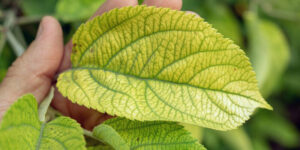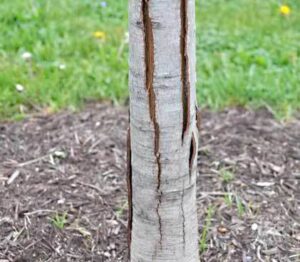By CSU Extension Horticulture Agent Linda Langelo
Colorado has its own unique weather conditions. Northeast Colorado is no different. We have extreme temperature changes which seem to be happening across the country now. But more than that we have little precipitation or flooding that occurs. For these reasons, we need tough and resilient plants which are long-lasting and non-invasive.

Our soils tend have an alkaline pH with pockets of properties leaning towards all sand or all clay. There are many places with sandy loam or clay loam soils that still have alkaline pH. The alkaline pH of 7.2 and above makes it impossible for plant roots to absorb nutrients such as iron, manganese, and zinc. Therefore, leaves on many of our plants exhibit yellowing with green veins.
The degree of yellowing on the leaves between the green veins can very and the thickness of the green around those veins can very pointing to differences in the nutrients that are lacking in the plant. The yellowing and green veins which occurs more toward the tip of the leaf is a sign of zinc deficiency and that can be similar for manganese, although manganese can turn the leaf olive-green and the leaves can also be stunted.

Due to our dramatic temperature changes, many times from a high of 75℉ to a low of 10℉ in less than twelve hours kills plants. Plants need a window to adapt to the temperature change. According to Dr. Klett, CSU Professor of Landscape Horticulture, Ornamentals and Nursery Management, trees that are fast-growing contain a higher internal moisture content than slower-growing trees. These fast-growing trees, such as Honeylocust, will easily sustain freeze damage in those conditions. This freeze damage can have a long lasting impact shortening the lives of trees and shrubs.
The next biggest issue facing all gardeners, and not just new gardeners in our area, is heavy wet snows early in the fall and late in the spring; after plants have leafed out. Heavy wet snow can break limbs and canes on many trees and plants. According to Dr. Klett, choosing trees that are less brittle such as lindens, oaks and conifers over Silver maple, Siberian elm and willows can eliminate broken limbs and damaged central leaders.
Though gardening here can be challenging, I still would encourage newcomers to garden! Knowing about the environmental conditions sets newcomers up for success. Take the time to learn about the trees growing in our area. Ask neighbors and new friends who garden here what they have in their landscape. Contact your local Colorado State University Extension Office for information available on what grows best in our area. You can also access information online at CSU Extension Plant Talk or the Grow and Give Program to find gardening information on trees, shrubs, herbs, and vegetables and much more.



